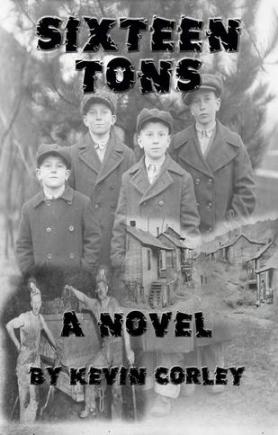Book Review:
Sixteen Tons, by Kevin Corley. A novel. Hardball Press. 2014.
From the opening pages of this historical novel, the reader is thrust headlong into the bloody struggles that were involved in building the American labor movement, particularly among the nation’s coal miners.
Spanning forty years from 1890 to 1930, this novel follows an Italian immigrant family from the mine fields of West Virginia into Central Illinois where the United Mineworkers found its earliest organizing successes, and with it wages and conditions that would ease the life of Antonio and Angeline Vacca and their four sons. The opening chapter begins with the chilling killing of African-American strikebreakers, brought by train from Alabama; a white union miner, who later befriends the Vaccas, fires shots that he believes may have killed one of the scabs, and the incident haunts him throughout the book.
It is the personalizing of these events, tracing miners battles from the tragedies of 1898 and 1899 in Virden and Pana, Illinois, that makes them so real. The Vaccas – in one way or another – become involved in all of the UMW struggles, including at Ludlow, Colorado, and Matewan, West Virginia, and the major massacre in 1922 at Herrin IL. Why connecting this immigrant family may seem a bit contrived, the author keeps it realistic and believable. The use of the Vacca family to portray the blood and tears that went into organizing the Mineworkers Union is an effective tool.
The author details the difficulty of a miner’s job, as he seeks to keep up with production goals so that he can earn enough to care for his family. His describes the dangers of shaft mining hundreds of feet below the earth, pointing the need to assure that the tunnels are shored up properly and the gases remain within safe limits.
It’s no picnic for the families above ground, who often must live in primitive conditions. Through all this the Vacca family survives, albeit not without family disputes and arguments over the miners’ union strategies.
The author is a retired Central Illinois schoolteacher who has spent much of his lifetime studying the miners of his area. He is to be commended for not gilding the lily, as the saying goes, by sugar-coating some of the misdeeds and in-fighting that characterized the UMW of the day.
After all, the story of building a union should be about the people within the union, and not the leadership. Ordinary people are not without warts, of course, and their victories are won in haphazard ways and often with losses on the battlefield. Like the Vacca family of this novel, people persevere and eventually victory comes.
This book relates all of that among its more than 400 pages. Most importantly, it opens our eyes to a history that should never be forgotten. – Ken Germanson, May 26, 2014.
